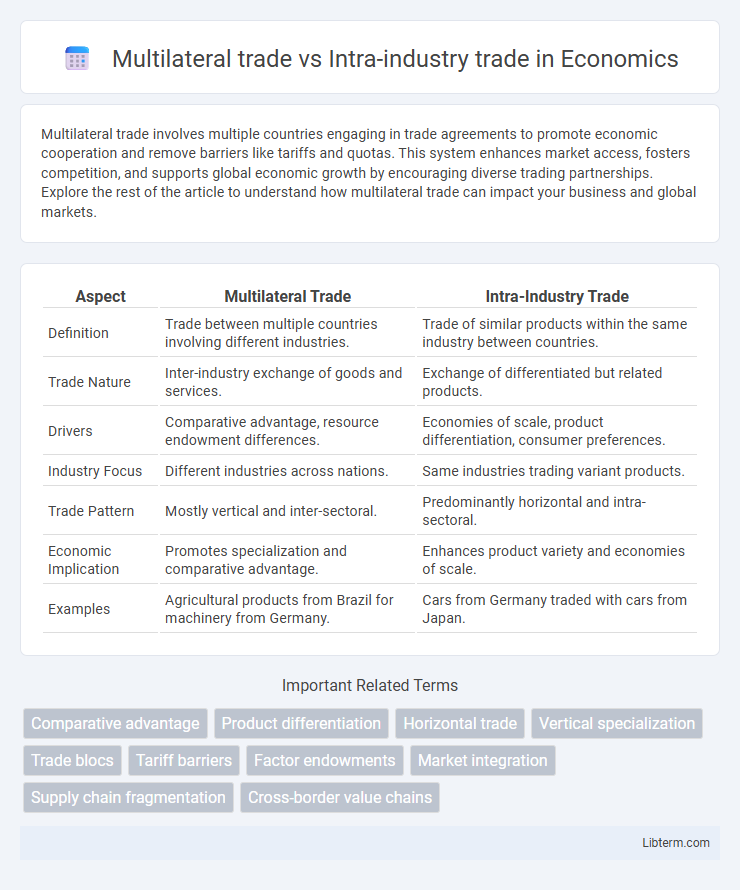Multilateral trade involves multiple countries engaging in trade agreements to promote economic cooperation and remove barriers like tariffs and quotas. This system enhances market access, fosters competition, and supports global economic growth by encouraging diverse trading partnerships. Explore the rest of the article to understand how multilateral trade can impact your business and global markets.
Table of Comparison
| Aspect | Multilateral Trade | Intra-Industry Trade |
|---|---|---|
| Definition | Trade between multiple countries involving different industries. | Trade of similar products within the same industry between countries. |
| Trade Nature | Inter-industry exchange of goods and services. | Exchange of differentiated but related products. |
| Drivers | Comparative advantage, resource endowment differences. | Economies of scale, product differentiation, consumer preferences. |
| Industry Focus | Different industries across nations. | Same industries trading variant products. |
| Trade Pattern | Mostly vertical and inter-sectoral. | Predominantly horizontal and intra-sectoral. |
| Economic Implication | Promotes specialization and comparative advantage. | Enhances product variety and economies of scale. |
| Examples | Agricultural products from Brazil for machinery from Germany. | Cars from Germany traded with cars from Japan. |
Understanding Multilateral Trade: Key Concepts
Multilateral trade involves exchange between multiple countries, emphasizing diverse goods and services, while intra-industry trade refers to countries simultaneously importing and exporting similar products within the same industry. Understanding multilateral trade requires analyzing comparative advantage, trade liberalization policies, and the impact of global supply chains on market access. This approach highlights the complexities of tariff negotiations, economic interdependence, and trade balances across multiple nations.
Defining Intra-Industry Trade in Modern Economies
Intra-industry trade refers to the exchange of similar products belonging to the same industry between countries, reflecting product differentiation and economies of scale in modern economies. Unlike multilateral trade, which often involves exchanging distinctly different goods based on comparative advantage, intra-industry trade emphasizes horizontal and vertical differentiation within sectors such as automotive, electronics, and pharmaceuticals. This trade pattern fosters specialization, innovation, and consumer choice while reducing market volatility in an interconnected global economy.
Historical Evolution: Multilateral vs Intra-Industry Trade
Multilateral trade evolved mainly from the post-World War II economic order, emphasizing comparative advantage and broad international cooperation through institutions like GATT and the WTO, fostering trade across diverse industries and countries. Intra-industry trade emerged prominently in the late 20th century with the growth of differentiated products and advanced economies, reflecting trade within the same industry based on product variety and scale economies. The historical evolution of multilateral trade contrasts with intra-industry trade by highlighting a shift from traditional inter-industry exchanges to more complex patterns driven by technology, consumer preferences, and globalization.
Major Drivers Behind Multilateral Trade
Multilateral trade is primarily driven by comparative advantage, enabling countries to specialize based on factor endowments, technology, and resource availability, leading to efficiency gains in the global market. Trade liberalization policies, such as reductions in tariffs and non-tariff barriers under agreements like the WTO, significantly facilitate multilateral trade by expanding market access and competitive dynamics. Infrastructure improvements, digitalization, and global supply chain integration further enhance multilateral trade by enabling smooth cross-border transactions and distribution networks among diverse economies.
Factors Influencing Intra-Industry Trade Growth
Factors influencing intra-industry trade growth include technological advancements that enhance product differentiation and economies of scale, allowing firms to specialize within the same industry. Market integration through trade agreements and reduced tariffs fosters increased intra-industry exchanges by expanding consumer choice and competitive dynamics. Furthermore, similarities in factor endowments and consumer preferences between trading partners encourage the parallel production and exchange of differentiated goods within industries.
Economic Benefits of Multilateral Trade Agreements
Multilateral trade agreements enhance economic efficiency by reducing tariffs and non-tariff barriers among multiple countries, fostering larger markets and greater competition. These agreements promote resource allocation based on comparative advantage, leading to increased specialization and higher productivity across industries. Economies participating in multilateral trade benefit from diversified export opportunities and improved terms of trade, which stimulate economic growth and consumer welfare.
Competitiveness & Innovation in Intra-Industry Trade
Intra-industry trade fosters competitiveness and innovation by enabling firms within the same industry and across countries to specialize in differentiated products, driving continuous improvement and product variety. This form of trade encourages investment in research and development as companies compete not only on price but on product features and technology. Consequently, economies engaged in intra-industry trade experience enhanced productivity gains and accelerated technological progress compared to the broader model of multilateral trade focused on comparative advantages.
Challenges and Risks: Multilateral vs Intra-Industry Trade
Multilateral trade faces challenges such as complex tariff negotiations, regulatory divergences, and potential trade wars that disrupt global supply chains and market access. Intra-industry trade involves risks related to high product differentiation, innovation cycles, and vulnerability to sector-specific shocks, which can impact competitive advantage and trade balances. Both trade types require robust policy frameworks to manage economic volatility, protect domestic industries, and ensure sustainable growth in increasingly interconnected markets.
Case Studies: Real-World Examples and Outcomes
Multilateral trade involves exchange among multiple countries, as seen in the World Trade Organization (WTO) agreements that promote global tariff reductions and non-discriminatory trade policies, enhancing overall economic efficiency. In contrast, intra-industry trade occurs when countries simultaneously import and export similar products within the same industry, exemplified by the automobile trade between Germany and France, which fosters specialization and economies of scale. Case studies such as NAFTA demonstrate how multilateral trade agreements boost cross-border investments, while examples like the European Union's single market highlight the significance of intra-industry trade in promoting innovation and competitive advantage.
Future Outlook: Trends Shaping Global Trade Dynamics
Multilateral trade is expected to adapt to increasing digitalization and environmental regulations, driving broader cooperation among diverse economies to tackle global challenges. Intra-industry trade will expand as advanced manufacturing technologies and customized product demands increase, fostering deeper specialization within sectors. Emerging markets are likely to play a pivotal role in shaping these trends, leveraging regional trade agreements and innovation to enhance competitive advantages.
Multilateral trade Infographic

 libterm.com
libterm.com